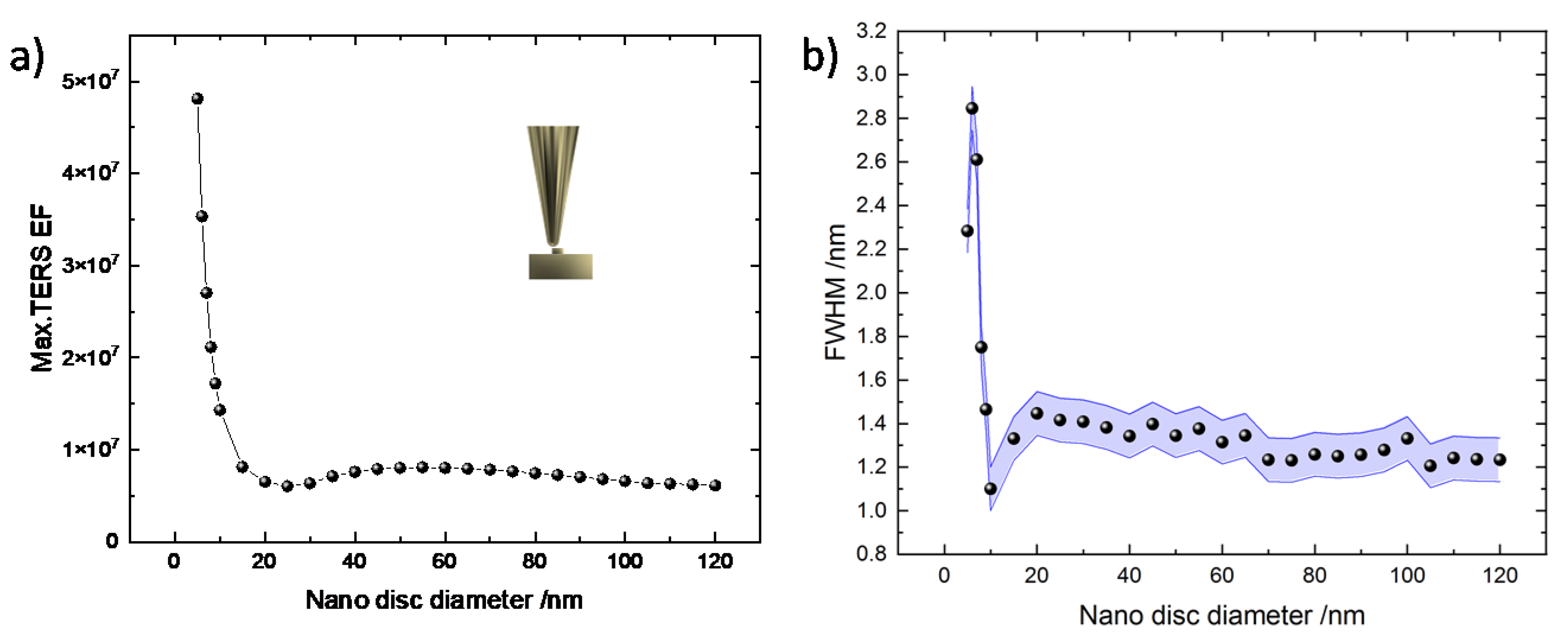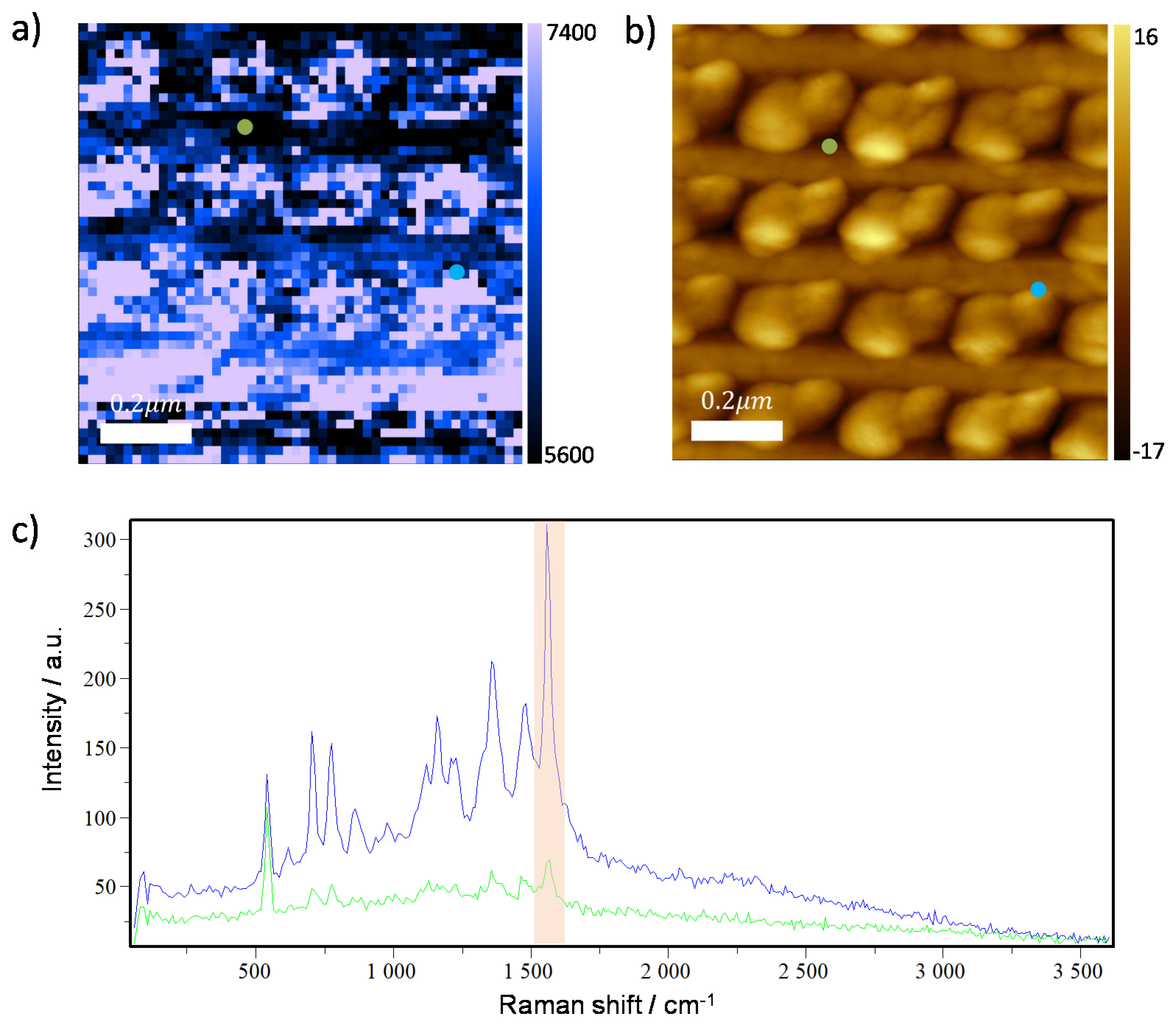Understanding the Role of Different Substrate Geometries for Achieving Optimum Tip-Enhanced Raman Scattering Sensitivity
Abstract
1. Introduction
2. Materials and Methods
2.1. 2D Numerical Methods and Geometries
2.2. 3D Numerical Methods and Models
2.3. Experimental Materials and Methods
3. Results and Discussion
3.1. 2D Simulation Results
3.1.1. Simulation Results on Conventional Gap-Mode TERS Configuration Shown in Figure 1a
3.1.2. Results on Tip Nanodisc Gap-Mode TERS Configuration Shown in Figure 1b
3.2. Experimental Results and 3D Simulation
4. Summary
Supplementary Materials
Author Contributions
Funding
Data Availability Statement
Acknowledgments
Conflicts of Interest
References
- Chen, C.; Hayazawa, N.; Kawata, S. A 1.7 Nm Resolution Chemical Analysis of Carbon Nanotubes by Tip-Enhanced Raman Imaging in the Ambient. Nat. Commun. 2014, 5, 3312. [Google Scholar] [CrossRef] [PubMed]
- Zhong, J.H.; Jin, X.; Meng, L.; Wang, X.; Su, H.S.; Yang, Z.L.; Williams, C.T.; Ren, B. Probing the Electronic and Catalytic Properties of a Bimetallic Surface with 3nm Resolution. Nat. Nanotechnol. 2017, 12, 132–136. [Google Scholar] [CrossRef] [PubMed]
- Rahaman, M.; Milekhin, A.G.; Mukherjee, A.; Rodyakina, E.E.; Latyshev, A.V.; Dzhagan, V.M.; Zahn, D.R.T. The Role of a Plasmonic Substrate on the Enhancement and Spatial Resolution of Tip-Enhanced Raman Scattering. Faraday Discuss. 2019, 214, 309–323. [Google Scholar] [CrossRef] [PubMed]
- Zhang, R.; Zhang, Y.; Dong, Z.C.; Jiang, S.; Zhang, C.; Chen, L.G.; Zhang, L.; Liao, Y.; Aizpurua, J.; Luo, Y.; et al. Chemical Mapping of a Single Molecule by Plasmon-Enhanced Raman Scattering. Nature 2013, 498, 82–86. [Google Scholar] [CrossRef] [PubMed]
- Zhang, C.; Chen, B.Q.; Li, Z.Y. Optical Origin of Subnanometer Resolution in Tip-Enhanced Raman Mapping. J. Phys. Chem. C 2015, 119, 11858–11871. [Google Scholar] [CrossRef]
- Chiang, N.; Chen, X.; Goubert, G.; Chulhai, D.V.; Chen, X.; Pozzi, E.A.; Jiang, N.; Hersam, M.C.; Seideman, T.; Jensen, L.; et al. Conformational Contrast of Surface-Mediated Molecular Switches Yields Ångstrom-Scale Spatial Resolution in Ultrahigh Vacuum Tip-Enhanced Raman Spectroscopy. Nano Lett. 2016, 16, 7774–7778. [Google Scholar] [CrossRef]
- Kumar, N.; Mignuzzi, S.; Su, W.; Roy, D. Tip-Enhanced Raman Spectroscopy: Principles and Applications. EPJ Tech. Instrum. 2015, 2. [Google Scholar]
- Etchegoin, P.G.; Le Ru, E.C. Basic Electromagnetic Theory of Surface Enhanced Raman Spectroscopy; Wiley: Hoboken, NJ, USA, 2010; ISBN 9783527632756. [Google Scholar]
- Yang, Z.; Aizpurua, J.; Xu, H. Electromagnetic Field Enhancement in TERS Configurations. J. Raman Spectrosc. 2009, 40, 1343–1348. [Google Scholar] [CrossRef]
- Ritchie, R.H. Plasma Losses by Fast Electrons in Thin Films. Phys. Rev. 1956, 106, 8. [Google Scholar] [CrossRef]
- Steidtner, J.; Pettinger, B. Tip-Enhanced Raman Spectroscopy and Microscopy on Single Dye Molecules with 15 Nm Resolution. Phys. Rev. Lett. 2008, 100, 1–4. [Google Scholar] [CrossRef] [PubMed]
- Pettinger, B.; Domke, K.F.; Zhang, D.; Picardi, G.; Schuster, R. Tip-Enhanced Raman Scattering: Influence of the Tip-Surface Geometry on Optical Resonance and Enhancement. Surf. Sci. 2009, 603, 1335–1341. [Google Scholar] [CrossRef]
- Stadler, J.; Schmid, T.; Zenobi, R. Nanoscale Chemical Imaging Using Top-Illumination Tip-Enhanced Raman Spectroscopy. Nano Lett. 2010, 10, 4514–4520. [Google Scholar] [CrossRef] [PubMed]
- Kumar, N.; Su, W.; Veselý, M.; Weckhuysen, B.M.; Pollard, A.J.; Wain, A.J. Nanoscale Chemical Imaging of Solid-Liquid Interfaces Using Tip-Enhanced Raman Spectroscopy. Nanoscale 2018, 10, 1815–1824. [Google Scholar] [CrossRef] [PubMed]
- Richard-Lacroix, M.; Zhang, Y.; Dong, Z.; Deckert, V. Mastering High Resolution Tip-Enhanced Raman Spectroscopy: Towards a Shift of Perception. Chem. Soc. Rev. 2017, 46, 3922–3944. [Google Scholar] [CrossRef] [PubMed]
- Rendell, R.W.; Scalapino, D.J. Surface Plasmons Confined by Microstructures on Tunnel Junctions. Phys. Rev. B 1981, 24, 3276–3294. [Google Scholar] [CrossRef]
- Zhu, W.; Esteban, R.; Borisov, A.G.; Baumberg, J.J.; Nordlander, P.; Lezec, H.J.; Aizpurua, J.; Crozier, K.B. Quantum Mechanical Effects in Plasmonic Structures with Subnanometre Gaps. Nat. Commun. 2016, 7, 1–14. [Google Scholar] [CrossRef]
- Liao, P.F.; Wokaun, A. Lightning Rod Effect in Surface Enhanced Raman Scattering. J. Chem. Phys. 1982, 76, 751–752. [Google Scholar] [CrossRef]
- Huang, T.X.; Huang, S.C.; Li, M.H.; Zeng, Z.C.; Wang, X.; Ren, B. Tip-Enhanced Raman Spectroscopy: Tip-Related Issues. Anal. Bioanal. Chem. 2015, 407, 8177–8195. [Google Scholar] [CrossRef]
- Ren, B.; Picardi, G.; Pettinger, B. Preparation of Gold Tips Suitable for Tip-Enhanced Raman Spectroscopy and Light Emission by Electrochemical Etching. Rev. Sci. Instrum. 2004, 75, 837–841. [Google Scholar] [CrossRef]
- Rodriguez, R.D.; Sheremet, E.; Müller, S.; Gordan, O.D.; Villabona, A.; Schulze, S.; Hietschold, M.; Zahn, D.R.T. Compact Metal Probes: A Solution for Atomic Force Microscopy Based Tip-Enhanced Raman Spectroscopy. Rev. Sci. Instrum. 2012, 83, 123708. [Google Scholar] [CrossRef]
- Xu, G.; Liu, Z.; Xu, K.; Zhang, Y.; Zhong, H.; Fan, Y.; Huang, Z. Constant Current Etching of Gold Tips Suitable for Tip-Enhanced Raman Spectroscopy. Rev. Sci. Instrum. 2012, 83, 103708. [Google Scholar] [CrossRef] [PubMed]
- Yang, L.K.; Huang, T.X.; Zeng, Z.C.; Li, M.H.; Wang, X.; Yang, F.Z.; Ren, B. Rational Fabrication of a Gold-Coated AFM TERS Tip by Pulsed Electrodeposition. Nanoscale 2015, 7, 18225–18231. [Google Scholar] [CrossRef] [PubMed]
- Gao, L.; Zhao, H.; Li, Y.; Li, T.; Chen, D.; Liu, B. Controllable Fabrication of Au-Coated AFM Probes via a Wet-Chemistry Procedure. Nanoscale Res. Lett. 2018, 13, 366. [Google Scholar] [CrossRef] [PubMed]
- Huang, T.X.; Li, C.W.; Yang, L.K.; Zhu, J.F.; Yao, X.; Liu, C.; Lin, K.Q.; Zeng, Z.C.; Wu, S.S.; Wang, X.; et al. Rational Fabrication of Silver-Coated AFM TERS Tips with a High Enhancement and Long Lifetime. Nanoscale 2018, 10, 4398–4405. [Google Scholar] [CrossRef] [PubMed]
- Bartolomeo, G.L.; Goubert, G.; Zenobi, R. Tip Recycling for Atomic Force Microscopy-Based Tip-Enhanced Raman Spectroscopy. Appl. Spectrosc. 2020, 74, 1358–1364. [Google Scholar] [CrossRef]
- Li, W.; Zhao, X.; Yi, Z.; Glushenkov, A.M.; Kong, L. Plasmonic Substrates for Surface Enhanced Raman Scattering. Anal. Chim. Acta 2017, 984, 19–41. [Google Scholar] [CrossRef]
- Chorsi, H.T.; Lee, Y.; Alù, A.; Zhang, J.X.J. Tunable Plasmonic Substrates with Ultrahigh Q-Factor Resonances. Sci. Rep. 2017, 7, 1–9. [Google Scholar] [CrossRef]
- Miranda, H.; Rabelo, C.; Cançado, L.G.; Vasconcelos, T.L.; Oliveira, B.S.; Schulz, F.; Lange, H.; Reich, S.; Kusch, P.; Jorio, A. Impact of Substrate on Tip-Enhanced Raman Spectroscopy—A Comparison of Frequency Domain Simulations and Graphene Measurements. arXiv 2020, arXiv:2001.06688. [Google Scholar]
- Yuksel, A.; Yu, E.T.; Murthy, J.; Cullinan, M. Effect of Substrate and Nanoparticle Spacing on Plasmonic Enhancement in Three-Dimensional Nanoparticle Structures. J. Micro Nano-Manuf. 2017, 5, 040903. [Google Scholar] [CrossRef]
- Tame, M.S.; McEnery, K.R.; Özdemir, Ş.K.; Lee, J.; Maier, S.A.; Kim, M.S. Quantum Plasmonics. Nat. Phys. 2013, 9, 329–340. [Google Scholar] [CrossRef]
- Jeon, H.B.; Tsalu, P.V.; Ha, J.W. Shape Effect on the Refractive Index Sensitivity at Localized Surface Plasmon Resonance Inflection Points of Single Gold Nanocubes with Vertices. Sci. Rep. 2019, 9, 13635. [Google Scholar] [CrossRef] [PubMed]
- Agrawal, A.; Kriegel, I.; Milliron, D.J. Shape-Dependent Field Enhancement and Plasmon Resonance of Oxide Nanocrystals. J. Phys. Chem. C 2015, 119, 6227–6238. [Google Scholar] [CrossRef]
- Benz, F.; Chikkaraddy, R.; Salmon, A.; Ohadi, H.; De Nijs, B.; Mertens, J.; Carnegie, C.; Bowman, R.W.; Baumberg, J.J. SERS of Individual Nanoparticles on a Mirror: Size Does Matter, but so Does Shape. J. Phys. Chem. Lett. 2016, 7, 2264–2269. [Google Scholar] [CrossRef] [PubMed]
- Jean-Pierre, B. A Perfectly Matched Layer for the Absorption of Electromagnetic Waves. J. Comput. Phys. 1994, 114, 185–200. [Google Scholar]
- McPeak, K.M.; Jayanti, S.V.; Kress, S.J.P.; Meyer, S.; Iotti, S.; Rossinelli, A.; Norris, D.J. Plasmonic Films Can Easily Be Better: Rules and Recipes. ACS Photonics 2015, 2, 326–333. [Google Scholar] [CrossRef]
- Milekhin, A.G.; Rahaman, M.; Rodyakina, E.E.; Latyshev, A.V.; Dzhagan, V.M.; Zahn, D.R.T. Giant Gap-Plasmon Tip-Enhanced Raman Scattering of MoS2 Monolayers on Au Nanocluster Arrays. Nanoscale 2018, 10, 2755–2763. [Google Scholar] [CrossRef]
- Kolwas, K.; Derkachova, A. Damping Rates of Surface Plasmons for Particles of Size from Nano- to Micrometers; Reduction of the Nonradiative Decay. J. Quant. Spectrosc. Radiat. Transf. 2013, 114, 45–55. [Google Scholar] [CrossRef]
- Politano, A.; Formoso, V.; Chiarello, G. Dispersion and Damping of Gold Surface Plasmon. Plasmonics 2008, 3, 165–170. [Google Scholar] [CrossRef]
- Zhou, N.; López-Puente, V.; Wang, Q.; Polavarapu, L.; Pastoriza-Santos, I.; Xu, Q.H. Plasmon-Enhanced Light Harvesting: Applications in Enhanced Photocatalysis, Photodynamic Therapy and Photovoltaics. RSC Adv. 2015, 5, 29076–29097. [Google Scholar] [CrossRef]
- Fang, P.-P.; Li, J.-F.; Yang, Z.-L.; Li, L.-M.; Ren, B.; Tian, Z.-Q. Optimization of SERS Activities of Gold Nanoparticles and Gold-core–Palladium-shell Nanoparticles by Controlling Size and Shell Thickness. J. Raman Spectrosc. 2008, 39, 1679–1687. [Google Scholar] [CrossRef]
- Tiggesbäumker, J.; Köller, L. Blue Shift Ofthe Mie Plasma Frequency in Ag Clusters and Particles. Phys. Rev. A 1993, 48, 1749–1752. [Google Scholar]
- Zhu, S.; Chen, T.P.; Cen, Z.H.; Goh, E.S.M.; Yu, S.F.; Liu, Y.C.; Liu, Y. Split of Surface Plasmon Resonance of Gold Nanoparticles on Silicon Substrate: A Study of Dielectric Functions. Opt. Express 2010, 18, 21926. [Google Scholar] [CrossRef] [PubMed]
- Downes, A.; Salter, D.; Elfick, A. Heating Effects in Tip-Enhanced Optical Microscopy. Opt. Express 2006, 14, 5216. [Google Scholar] [CrossRef] [PubMed]
- Downes, A.; Salter, D.; Elfick, A. Finite Element Simulations of Tip-Enhanced Raman and Fluorescence Spectroscopy. J. Phys. Chem. B 2006, 110, 6692–6698. [Google Scholar] [CrossRef] [PubMed]
- Alvarez, M.M.; Khoury, J.T.; Schaaff, T.G.; Shafigullin, M.N.; Vezmar, I.; Whetten, R.L. Optical Absorption Spectra of Nanocrystal Gold Molecules. J. Phys. Chem. B 1997, 101, 3706–3712. [Google Scholar] [CrossRef]
- Andrew Downes; Donald Salter; Alistair Ilfick Simulations of Tip-Enhanced Optical Microscopy Reveal Atomic Resolution. J. Microsc. 2008, 229, 184–188. [CrossRef]
- Shi, X.; Coca-López, N.; Janik, J.; Hartschuh, A. Advances in Tip-Enhanced near-Field Raman Microscopy Using Nanoantennas. Chem. Rev. 2017, 117, 4945–4960. [Google Scholar] [CrossRef]
- Kelly, K.L.; Coronado, E.; Zhao, L.L.; Schatz, G.C. The Optical Properties of Metal Nanoparticles: The Influence of Size, Shape, and Dielectric Environment. J. Phys. Chem. B 2003, 107, 668–677. [Google Scholar] [CrossRef]
- Campos, A.; Troc, N.; Cottancin, E.; Pellarin, M.; Weissker, H.C.; Lermé, J.; Kociak, M.; Hillenkamp, M. Plasmonic Quantum Size Effects in Silver Nanoparticles Are Dominated by Interfaces and Local Environments. Nat. Phys. 2019, 15, 275–280. [Google Scholar] [CrossRef]
- Christensen, T.; Yan, W.; Jauho, A.P.; Soljačić, M.; Mortensen, N.A. Quantum Corrections in Nanoplasmonics: Shape, Scale, and Material. Phys. Rev. Lett. 2017, 118, 1–6. [Google Scholar] [CrossRef]
- Barbry, M.; Koval, P.; Marchesin, F.; Esteban, R.; Borisov, A.G.; Aizpurua, J.; Sánchez-Portal, D. Atomistic Near-Field Nanoplasmonics: Reaching Atomic-Scale Resolution in Nanooptics. Nano Lett. 2015, 15, 3410–3419. [Google Scholar] [CrossRef] [PubMed]
- Milekhin, A.G.; Kuznetsov, S.A.; Sveshnikova, L.L.; Duda, T.A.; Milekhin, I.A.; Rodyakina, E.E.; Latyshev, A.V.; Dzhagan, V.M.; Zahn, D.R.T. Surface-Enhanced Infrared Absorption by Optical Phonons in Nanocrystal Monolayers on Au Nanoantenna Arrays. J. Phys. Chem. C 2017, 121, 5779–5786. [Google Scholar] [CrossRef]
- Rahaman, M.; Rodriguez, R.D.; Plechinger, G.; Moras, S.; Schüller, C.; Korn, T.; Zahn, D.R.T. Highly Localized Strain in a MoS2/Au Heterostructure Revealed by Tip-Enhanced Raman Spectroscopy. Nano Lett. 2017, 17, 6027–6033. [Google Scholar] [CrossRef] [PubMed]
- Milekhin, I.A.; Rahaman, M.; Anikin, K.V.; Rodyakina, E.E.; Duda, T.A.; Saidzhonov, B.M.; Vasiliev, R.B.; Dzhagan, V.M.; Milekhin, A.G.; Latyshev, A.V.; et al. Resonant Tip-Enhanced Raman Scattering by CdSe Nanocrystals on Plasmonic Substrates. Nanoscale Adv. 2020, 2, 5441–5449. [Google Scholar] [CrossRef]






| Tip on Flat Gold | Tip on Edge of Nanodisc | |
|---|---|---|
| 2D simulation | ||
| 3D simulation |
Publisher’s Note: MDPI stays neutral with regard to jurisdictional claims in published maps and institutional affiliations. |
© 2021 by the authors. Licensee MDPI, Basel, Switzerland. This article is an open access article distributed under the terms and conditions of the Creative Commons Attribution (CC BY) license (http://creativecommons.org/licenses/by/4.0/).
Share and Cite
He, L.; Rahaman, M.; Madeira, T.I.; Zahn, D.R.T. Understanding the Role of Different Substrate Geometries for Achieving Optimum Tip-Enhanced Raman Scattering Sensitivity. Nanomaterials 2021, 11, 376. https://doi.org/10.3390/nano11020376
He L, Rahaman M, Madeira TI, Zahn DRT. Understanding the Role of Different Substrate Geometries for Achieving Optimum Tip-Enhanced Raman Scattering Sensitivity. Nanomaterials. 2021; 11(2):376. https://doi.org/10.3390/nano11020376
Chicago/Turabian StyleHe, Lu, Mahfujur Rahaman, Teresa I. Madeira, and Dietrich R.T. Zahn. 2021. "Understanding the Role of Different Substrate Geometries for Achieving Optimum Tip-Enhanced Raman Scattering Sensitivity" Nanomaterials 11, no. 2: 376. https://doi.org/10.3390/nano11020376
APA StyleHe, L., Rahaman, M., Madeira, T. I., & Zahn, D. R. T. (2021). Understanding the Role of Different Substrate Geometries for Achieving Optimum Tip-Enhanced Raman Scattering Sensitivity. Nanomaterials, 11(2), 376. https://doi.org/10.3390/nano11020376









